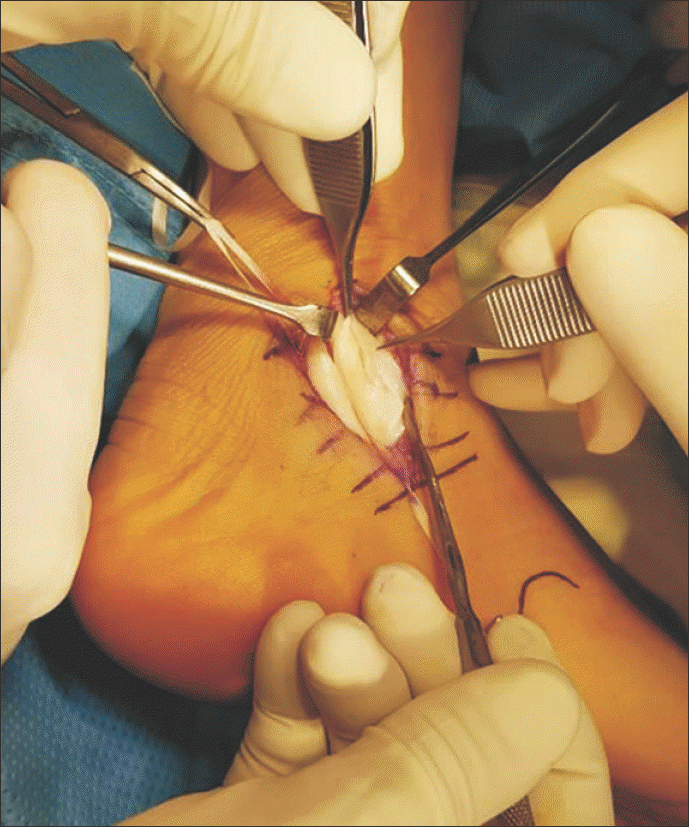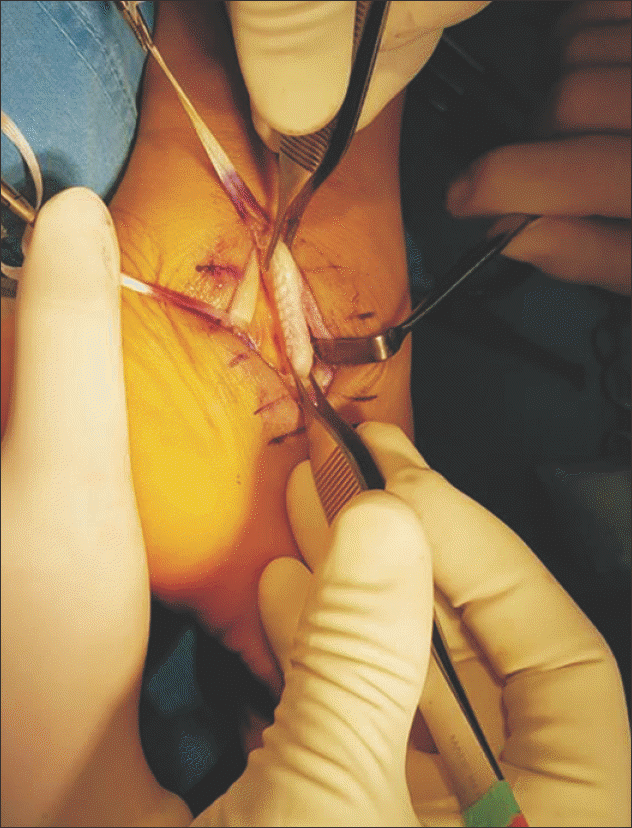Abstract
Purpose:
This study examined the clinical outcomes and assessed the average time to return to play following a peroneal tendon repair in Korean athletes.
Materials and Methods:
Between March 2004 and February 2017, a total of 30 athletes underwent peroneal tendon repair for a peroneal tendon tear. The indications of surgical treatment were chronic pain or intractable symptoms after a previous ankle sprain affecting sports activity refractory to conservative treatment for at least six months. The patient underwent tubulization for a longitudinal tendon rupture. Peroneus longus to peroneus brevis tenodesis was performed when tendon repair was impossible due to total rupture or multiple longitudinal rupture.
Results:
Twenty patients not included in this study were as follows: insufficient follow-up, previous surgery, and additional bone surgery. All 10 patients had a previous ankle sprain history, tenderness and swelling on the retromalleolar area. In the 10 patient population, there were five peroneus brevis tendon tears, three peroneus longus tendon tears, one peroneus longus and brevis tendon tear, and one peroneus brevis and superior peroneal retinaculum tear. In the 10 patients, six cases of peroneal brevis tendon repair and four cases of peroneal longus to brevis tenodesis were performed. The preoperative American Orthopaedic Foot and Ankle Society score was improved from a mean of 60.6 (standard deviation [SD], 8.64) to a mean of 90.2, postoperatively (SD, 4.4; p<0.012). The preoperative visual analogue scale was improved from a mean of 5.43 (SD, 1.2) to 0.5 (SD, 0.16), postoperatively (p<0.023). The mean length of time to return to play was 12.2 weeks (range, 8∼16 weeks).
Go to : 
REFERENCES
1.Anderson KJ., Lecocq JF. Operative treatment of injury to the fibular collateral ligament of the ankle. J Bone Joint Surg Am. 1954. 36:825–32.

2.Burman M. Stenosing tendovaginitis of the foot and ankle; studies with special reference to the stenosing tendovaginitis of the peroneal tendons of the peroneal tubercle. AMA Arch Surg. 1953. 67:686–98.
3.Dombek MF., Lamm BM., Saltrick K., Mendicino RW., Catanzariti AR. Peroneal tendon tears: a retrospective review. J Foot Ankle Surg. 2003. 42:250–8.

4.Ferran NA., Oliva F., Maffulli N. Recurrent subluxation of the peroneal tendons. Sports Med. 2006. 36:839–46. DOI: doi: 10.2165/00007256-200636100-00003.

5.Larsen E. Longitudinal rupture of the peroneus brevis tendon. J Bone Joint Surg Br. 1987. 69:340–1.

6.Wind WM., Rohrbacher BJ. Peroneus longus and brevis rupture in a collegiate athlete. Foot Ankle Int. 2001. 22:140–3.

7.Lee KT., Park YU., Kim JS., Kim JB., Kim KC., Kang SK. Long-term results after modified Brostrom procedure without calcaneofibular ligament reconstruction. Foot Ankle Int. 2011. 32:153–7. DOI: doi: 10.3113/FAI.2011.0153.

8.Chinn L., Hertel J. Rehabilitation of ankle and foot injuries in athletes. Clin Sports Med. 2010. 29:157–67. DOI: doi: 10.1016/j.csm.2009.09.006.

9.DIGiovanni BF., Fraga CJ., Cohen BE., Shereff MJ. Associated injuries found in chronic lateral ankle instability. Foot Ankle Int. 2000. 21:809–15. DOI: doi: 10.1177/107110070002101003.

10.Young KW., Park YU., Kim JS., Cho HK., Choo HS., Park JH. Misdiagnosis of talar body or neck fractures as ankle sprains in low Vol. 23 No. 3, September 2019 energy traumas. Clin Orthop Surg. 2016. 8:303–9. DOI: doi: 10.4055/cios.2016.8.3.303.
11.Sammarco GJ. Peroneus longus tendon tears: acute and chronic. Foot Ankle Int. 1995. 16:245–53. DOI: doi: 10.1177/107110079501600501.

12.Clarke HD., Kitaoka HB., Ehman RL. Peroneal tendon injuries. Foot Ankle Int. 1998. 19:280–8. DOI: doi: 10.1177/107110079801900503.

13.Karlsson J., Wiger P. Longitudinal split of the peroneus brevis tendon and lateral ankle instability: treatment of concomitant lesions. J Athl Train. 2002. 37:463–6.
15.Squires N., Myerson MS., Gamba C. Surgical treatment of peroneal tendon tears. Foot Ankle Clin. 2007. 12:675–95. DOI: doi: 10.1016/j.fcl.2007.08.002.

16.Redfern D., Myerson M. The management of concomitant tears of the peroneus longus and brevis tendons. Foot Ankle Int. 2004. 25:695–707. DOI: doi: 10.1177/107110070402501002.

17.Krause JO., Brodsky JW. Peroneus brevis tendon tears: pathophysiology, surgical reconstruction, and clinical results. Foot Ankle Int. 1998. 19:271–9. DOI: doi: 10.1177/107110079801900502.

18.Heckman DS., Reddy S., Pedowitz D., Wapner KL., Parekh SG. Operative treatment for peroneal tendon disorders. J Bone Joint Surg Am. 2008. 90:404–18. DOI: doi: 10.2106/JBJS.G.00965.

19.Demetracopoulos CA., Vineyard JC., Kiesau CD., Nunley JA 2nd. Long-term results of debridement and primary repair of peroneal tendon tears. Foot Ankle Int. 2014. 35:252–7. DOI: doi: 10.1177/1071100713514565.

20.Steel MW., DeOrio JK. Peroneal tendon tears: return to sports after operative treatment. Foot Ankle Int. 2007. 28:49–54. DOI: doi: 10.3113/FAI.2007.0009.

21.Alanen J., Orava S., Heinonen OJ., Ikonen J., Kvist M. Peroneal tendon injuries. Report of thirty-eight operated cases. Ann Chir Gynaecol. 2001. 90:43–6.
Go to : 
 | Figure 1.In the operative field, a split tear and degenerative change of the peroneus brevis tendon are visible. |
Table 1.
This Table Shows the Schedule of Functional Rehabilitation
| Stage | Rehabilitation schedule |
|---|---|
| 1st | Balance exercise |
| 2nd | Walking in a straight line |
| 3rd | Jogging in a straight line |
| 4th | Jump |
| 5th | Cutting |
Table 2.
Clinical Data of the Patients




 PDF
PDF ePub
ePub Citation
Citation Print
Print



 XML Download
XML Download